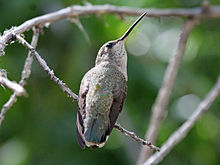Costa's hummingbird
| Costa's hummingbird | |
|---|---|

| |

| |
| Male above, female below | |
| Scientific classification | |
| Domain: | Eukaryota |
| Kingdom: | Animalia |
| Phylum: | Chordata |
| Class: | Aves |
| Clade: | Strisores |
| Order: | Apodiformes |
| Family: | Trochilidae |
| Genus: | Calypte |
| Species: | C. costae |
| Binomial name | |
| Calypte costae (Bourcier, 1839) | |

| |
| Range of C. costae Breeding range Year-round range Wintering range | |
Costa's hummingbird (Calypte costae) is a bird species in the hummingbird family Trochilidae.[3] It breeds in the arid region of the southwest United States and northwest Mexico; it winters in western Mexico.[3]
Taxonomy
Costa's hummingbird was formally described by the French ornithologist Jules Bourcier in 1839 and given the binomial name Ornismya costae.[4] Bourcier chose the specific epithet to honour the French nobleman Louis Marie Pantaleon Costa, Marquis de Beauregard (1806–1864).[5] The type locality is Magdalena Bay on the western coast of the Mexican state of Baja California Sur.[6] Costa's hummingbird is now placed in the genus Calypte that was introduced in 1856 by John Gould.[7][8] The species is monotypic: no subspecies are recognised.[8]
Hybrids between this species and Anna's hummingbird, the black-chinned hummingbird as well as the broad-tailed hummingbird are known.[9]
Description
This species is small, as a mature adult grows to only 3–3.5 in (7.6–8.9 cm) in length, with a wingspan of 11 cm,[10] and an average weight of 3.05 g for males and 3.22 g for females.[3][11] The male has a mainly green back and flanks, a small black tail and wings, and patches of white below their gorgeted throat and tail. Its most distinguishing feature is its vibrant purple cap and throat with the throat feathers flaring out and back behind its head.[3] The female is not as distinct as the male, having grayish-green above with a white underbelly.[3]
Distribution and habitat
Costa's hummingbird is common in the arid brushy deserts and gardens of the Southwestern United States and the Baja California Peninsula of Mexico.[3]
Behavior
Breeding

The male Costa's hummingbird's courtship display is a spirited series of swoops and arcing dives, using an angle to the sun to display its violet extended gorget to prospective mates.[12] The male makes a high-speed dive pass or hover close to the female, perched on a nearby branch, and is accented by a high-pitched vibration that is produced by tail feathers. Separately, the male will perch and produce a high-pitched, scratch-like song.[3]
The female constructs a small cup-shaped nest out of plant fibers, down, and at times spider silk, coated with lichen to hold it together.[13] The nest is situated on a yucca stalk or tree limb. The female lays just two eggs, which are white in color, which she will incubate for 15 to 18 days before the young hatch. The young leave the nest after 20 to 23 days.
Diet
As common with hummingbird species, Costa's hummingbird feeds on flower nectar and small insects. While feeding in flight, a Costa's hummingbird may hover.
- Female hovering
- Male hovering
Torpor
As with other hummingbird species, the Costa's hummingbird can slow its metabolism during cold nights when it enters a hibernation-like state known as torpor, with its heart rate and respiration slowing substantially.[3]
Conservation
The IUCN describes them as of least concern. The population is stable and there are no known threats. They are found in at least one protected area.[14]
References
- ^ BirdLife International (2016). "Calypte costae". IUCN Red List of Threatened Species. 2016: e.T22688202A93187017. doi:10.2305/IUCN.UK.2016-3.RLTS.T22688202A93187017.en. Retrieved 12 November 2021.
- ^ "Appendices | CITES". cites.org. Retrieved 2022-01-14.
- ^ a b c d e f g h "Costa's hummingbird". All About Birds, Cornell University. 2023. Retrieved 27 December 2023.
- ^ Bourcier, Jules (1839). "Description de quelques espèces nouvelles d'oiseaux-mouches". Revue Zoologique (in French). 2: 294–295 [294].
- ^ Jobling, James A. (2010). The Helm Dictionary of Scientific Bird Names. London: Christopher Helm. p. 120. ISBN 978-1-4081-2501-4.
- ^ Peters, James Lee, ed. (1945). Check-List of Birds of the World. Vol. 5. Cambridge, Massachusetts: Harvard University Press. pp. 136–137.
- ^ Gould, John (1856). A Monograph of the Trochilidae, or Family of Humming-Birds. Vol. 4. London: self. Plates 134, 135, 136 and text (Part 11, Plates 5, 6 and 7). The 5 volumes were issued in 25 parts between 1849 and 1861. Title pages of all volumes bear the date of 1861.
- ^ a b Gill, Frank; Donsker, David; Rasmussen, Pamela, eds. (January 2021). "Hummingbirds". IOC World Bird List Version 11.1. International Ornithologists' Union. Retrieved 1 March 2021.
- ^ Huey, Laurence M. (1944). "A hybrid Costa's x Broad-tailed hummingbird" (PDF). The Auk. 61 (4): 636–637. doi:10.2307/4080185. JSTOR 4080185.
- ^ Oiseaux.net. "Colibri de Costa - Calypte costae - Costa's Hummingbird". www.oiseaux.net. Retrieved 2020-09-26.
- ^ "Costa's hummingbird". www.hummingbirds.net. Retrieved 2020-09-26.
- ^ "No CGI here: The Costa's hummingbird woos mates with this freaky face". Earth Touch News Network. 2014.
- ^ Woods, Robert S. (1922). "The development of young Costa hummingbirds" (PDF). The Condor. 24 (6): 189–193. doi:10.2307/1362578. JSTOR 1362578.
- ^ "The IUCN Red List of Threatened Species". IUCN Red List of Threatened Species.
External links
- "Costa's Hummingbird media". Internet Bird Collection.
- Costa's Hummingbird photo gallery at VIREO (Drexel University)



